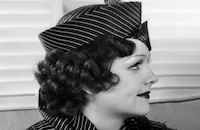Sally

Brief Synopsis
Cast & Crew
John Francis Dillon
Marilyn Miller
Alexander Gray
Joe E. Brown
T. Roy Barnes
Pert Kelton
Film Details
Technical Specs

Synopsis
Sally, a cafe hostess and orphan, aspires to become a dancer. She is loved by Blair Farquar, of an aristocratic family, though his father has arranged a match with Marcia Ten Brock. Forced to leave the cafe when she spills food on the suit of Otis Hooper, a booking agent, she gets a job at the Balkan Tavern, run by "Pops" Shendorff, onetime supporter of a former grand duke who now works as a waiter and is known as Connie. Encouraged to dance for the customers, Sally is a sensation, and when Hooper engages her to impersonate a Russian dancer who has eloped, she and Connie are lionized at Mrs. Ten Brock's party. When Sally learns Farquar is engaged to Marcia, however, she leaves the party in despair. Hooper finds her in a tenement and stars her in his follies, and on her opening night, she is reunited with her lover. Their marriage follows.

Director

John Francis Dillon
Cast

Marilyn Miller

Alexander Gray

Joe E. Brown
T. Roy Barnes

Pert Kelton

Ford Sterling
Maude Turner Gordon
Nora Lane
E. J. Ratcliffe
Jack Duffy
Albertina Rasch Ballet
Crew
Joe Burke
Larry Ceballos
B. G. Desylva
Al Dubin
Leo Forbstein
Clifford Grey
Dev Jennings
Jerome Kern
C. Edgar Schoenbaum
Edward Stevenson
Jack Stone
Leroy Stone
Waldemar Young
Waldemar Young

Film Details
Technical Specs

Award Nominations
Best Art Direction
Articles
Sally (1930) -
By Violet LeVoit

Sally (1930) -
Quotes
Trivia
Although this film survives in black and white, the color sequences are lost.
Fragments of the color film for the "Wild Rose" song and dance number were found in the 1990s and have been intercut into the print that Turner Classic Movies shows on its cable channel.
Notes
Remake of the 1925 silent film of the same title.














